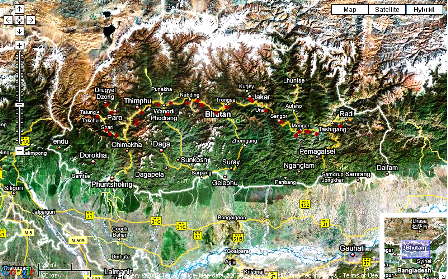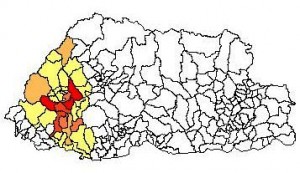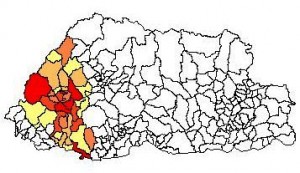Yes, that’s what the news item said, and it got me all excited. So I rushed off to SINGER first to see if there’s any germplasm from that country in the international collections, and if any of that was geo-referenced. And I was happy to find some 30 barleys at ICARDA, strung all along the main road, from east to west.
And so then I went off to CountrySTAT-Bhutan to see how well this material covered the distribution of the crop. The results were a little weird. This is the distribution of barley cultivation in Bhutan in 2005.
As you can see, the crop is concentrated in the west of the country, whereas in 1981, when the ICARDA collection was made, that seemed not to be the case. Ok, things change. The oldest data in CountrySTAT-Bhutan is 1999, but the pattern is the same.
Has the distribution of barley in Bhutan really changed so drastically in the past 30 years or so? And if so, what has that done to genetic diversity? Have the landraces formerly found in the east migrated, or are they only to be found in genebanks now?



In Guatemala a geographer (Oscar Horst) found that crops that cover small proportions of land tend to be underreported in the agricultural census. If barley cultivation is less frequent in the east, that possibility would reconcile the two maps. The white should be a very light tone of yellow, really.
But would having more samples in the west increase the overall diversity keeping the same number of samples?
Very good case. However, some thoughts arise. Thirty years is long enough time to allow things to change. Agricultural systems changing, agricultural systems’ components that disappear, are replaced or participate in different compositions etc. In any case, a dramatic shift in cultivation area for a crop is more difficult to happen in a period such as 30 years, like the one shown above.
Without having access to field notes, collecting mission reports, etc., it’s difficult to judge since we do not know the objectives of the collecting. Did the collecting intentionally targeted the fringes of the main cultivation area? It is well known that very interesting material is found in the limits of the agro-ecological distribution of a crop, where species have to deal with adverse conditions, thus developing adaptation mechanisms that are of great importance to breeding.
I would be very interested to follow up the development of this case should someone have access to the mission reports and could shed some light on the main objectives, sampling strategies and findings of the collecting missions that took place in the country 30 years ago